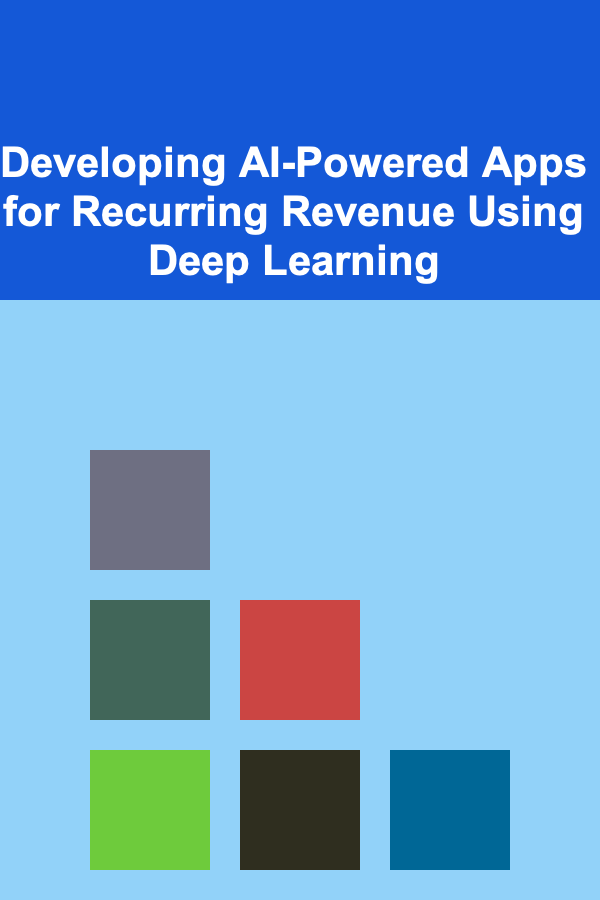
Developing AI-Powered Apps for Recurring Revenue Using Deep Learning
ebook include PDF & Audio bundle (Micro Guide)
$12.99$11.99
Limited Time Offer! Order within the next:

In recent years, artificial intelligence (AI) has become an indispensable tool for building innovative applications that can drive significant business value. Among the most powerful subsets of AI is deep learning, a technology that has revolutionized industries by enabling machines to learn and perform complex tasks. From image recognition and natural language processing (NLP) to automated decision-making systems, deep learning has opened up new possibilities for app development.
This article explores how developers can leverage deep learning to build AI-powered applications with the potential for generating recurring revenue. We'll examine the fundamental concepts of deep learning, why it's a game-changer for app developers, and provide actionable strategies for building scalable, profitable apps that generate consistent income over time.
Understanding Deep Learning and Its Potential
Deep learning, a subfield of machine learning, is inspired by the structure and functioning of the human brain. It utilizes artificial neural networks (ANNs) to recognize patterns in large volumes of data and make predictions or decisions without explicit programming. The power of deep learning lies in its ability to automatically extract relevant features from raw data, making it capable of performing tasks that were previously unimaginable for traditional algorithms.
Deep learning excels in a variety of domains, including:
- Computer vision: Recognizing objects, faces, and scenes in images or videos.
- Natural language processing: Understanding and generating human language, enabling chatbots, sentiment analysis, and translation.
- Speech recognition: Converting audio data into text, enabling virtual assistants like Siri and Google Assistant.
- Reinforcement learning: Optimizing decision-making in dynamic environments, useful in areas like robotics and gaming.
These capabilities make deep learning a perfect tool for creating applications that can not only perform complex tasks but also deliver value to users in ways that traditional applications cannot. Furthermore, with the rise of cloud computing and powerful deep learning frameworks like TensorFlow, PyTorch, and Keras, it has become easier than ever for developers to build sophisticated AI-powered applications.
Why Build AI-Powered Apps for Recurring Revenue?
Creating a deep learning-powered application opens up a wealth of opportunities for generating recurring revenue. Recurring revenue refers to income that continues to flow into a business over time with minimal effort after the initial setup. This can come from subscription models, licensing, or pay-per-use services.
There are several reasons why deep learning-powered apps are particularly suited for generating recurring revenue:
1. Scalability
Once a deep learning model is trained and integrated into an application, it can often handle vast amounts of data without significant degradation in performance. This scalability allows developers to expand their app's user base and functionality without needing to significantly increase operational costs.
2. Automation
Deep learning apps can automate complex tasks like data analysis, content generation, or customer support, which are critical in driving recurring business value. With automation, businesses can reduce operational overhead and improve user satisfaction, leading to higher retention rates and more consistent revenue.
3. Continuous Improvement
Unlike traditional apps, deep learning applications have the capacity to continuously learn from new data. Over time, they improve their performance, accuracy, and effectiveness. This ability to adapt and improve makes these applications more valuable to users, encouraging long-term subscriptions or usage.
4. High User Engagement
AI-powered applications, especially those that provide personalized experiences (e.g., recommendations, content curation, chatbots), tend to have higher user engagement. This leads to higher retention rates and increases the likelihood of recurring revenue streams, such as subscription renewals or in-app purchases.
5. New Revenue Models
AI opens the door to new business models, such as Software-as-a-Service (SaaS) or licensing of deep learning models. These models are designed to be scalable and can create revenue streams that continue to grow over time.
Key Strategies for Building AI-Powered Apps with Recurring Revenue
1. Identify a Market Need
The first step in building any successful app, including one powered by deep learning, is identifying a real-world problem that your app can solve. Deep learning is particularly powerful in domains with large amounts of data or complex decision-making, where traditional algorithms may struggle.
Common industries that benefit from AI-powered apps include:
- Healthcare: Diagnostic tools, disease prediction, and personalized treatment recommendations.
- Finance: Fraud detection, automated trading, and risk analysis.
- E-commerce: Personalized recommendations, dynamic pricing, and inventory management.
- Education: Personalized learning paths, chatbots, and automated grading systems.
- Entertainment: Content curation, automated video editing, and music composition.
By focusing on a specific niche, you can build an app that addresses a tangible need and has a clear value proposition.
2. Choose the Right Deep Learning Models
Different deep learning models are suited to different types of tasks. The choice of model will depend on the nature of the application and the type of data being processed. Here are some examples of models commonly used in AI-powered apps:
- Convolutional Neural Networks (CNNs): Used in image processing and computer vision tasks.
- Recurrent Neural Networks (RNNs): Suitable for sequential data such as time series, speech, or text.
- Transformers: Ideal for NLP tasks like translation, summarization, and text generation.
- Generative Adversarial Networks (GANs): Often used for generating realistic images, art, or even text.
You must ensure that your chosen model can handle the specific tasks required by your app. Moreover, you should consider whether the model can be trained using publicly available data or if you will need to gather proprietary datasets.
3. Develop a Scalable Backend Infrastructure
Scalability is a key consideration when building deep learning-powered apps. Once the model is deployed, the app should be able to handle a growing number of users and increasing data without significant performance degradation.
Cloud services like AWS, Google Cloud, and Microsoft Azure offer powerful solutions for deploying AI models. They provide scalable infrastructure, including GPU instances for training models and APIs for serving predictions, making it easier to build AI-powered apps that can grow over time.
4. Implement Recurring Revenue Models
There are several ways to monetize an AI-powered app using recurring revenue models. The choice of model will depend on the nature of your app, the target audience, and the value proposition.
Here are some recurring revenue models you can consider:
- Subscription-Based Model: Offer your app as a monthly or yearly subscription. This model works well for apps that provide continuous value, such as content recommendations, real-time analytics, or personalized experiences.
- Freemium Model: Provide a free version of the app with basic functionality and offer premium features through a paid subscription. For example, an AI-powered photo editing app could offer basic filters for free and charge for advanced editing tools.
- Pay-Per-Use Model: Charge users based on the amount of usage. This model works well for apps that provide services with variable usage, such as API calls, cloud-based processing, or data analysis.
- Licensing: If your app's core functionality relies on a deep learning model that could be useful for other developers, consider licensing the model to other businesses or developers.
5. Focus on User Experience
A seamless user experience is critical for the success of any app. Users need to see immediate value and understand how to interact with the app's AI features without confusion. It's also important to offer continuous support, updates, and improvements to maintain a high level of satisfaction.
For example, if you're building an AI-powered chatbot app, make sure the AI understands user queries accurately, responds quickly, and offers clear actions. If users find the app helpful and easy to use, they're more likely to stick around, renew their subscriptions, or recommend it to others.
6. Leverage Data and Feedback for Continuous Improvement
Deep learning apps thrive on data. The more data they can access, the more accurate and effective they become. Over time, you can use the data collected from your users to refine your models and improve the app's performance. Feedback loops are vital for ensuring that your app stays relevant and valuable to its users.
Incorporating user feedback into your model training can help you identify areas of improvement. For example, if your app is a recommendation system, you can continually refine it by training the model on new user behavior data. As the app improves, it will generate more value for users, increasing engagement and retention.
7. Marketing and Customer Retention
Once your app is developed, you'll need an effective marketing strategy to attract users and build brand loyalty. Some marketing tactics to consider include:
- Content marketing: Write blogs, create tutorials, or produce videos explaining how your AI-powered app solves specific problems.
- Referral programs: Offer existing users incentives to refer new users.
- Social media: Use social media platforms to showcase your app's capabilities and connect with potential users.
- Search engine optimization (SEO): Optimize your website and app store listing to ensure that people can find your app when searching for related solutions.
Retaining users is just as important as acquiring them. By continuously improving your app, offering excellent customer service, and engaging users with new features, you can keep your users satisfied and encourage them to continue paying for the app over the long term.
Challenges in Developing AI-Powered Apps for Recurring Revenue
While the potential for recurring revenue through AI-powered apps is substantial, there are several challenges to consider:
- Data Privacy and Security: AI-powered apps often require large amounts of data to train models. Ensuring that data is collected, stored, and processed securely is essential for maintaining user trust.
- Model Training and Maintenance: Deep learning models require significant computational resources to train and fine-tune. Additionally, they may require ongoing updates to stay accurate as data evolves.
- User Trust and Adoption: Users need to trust that your AI app is reliable and capable of delivering the promised results. Demonstrating the effectiveness of your AI model through case studies, testimonials, or trial periods can help build that trust.
Conclusion
Developing AI-powered apps for recurring revenue using deep learning is an exciting and profitable opportunity. By identifying market needs, choosing the right deep learning models, and implementing effective monetization strategies, you can build apps that offer real value to users while generating consistent income over time.
However, success in this space requires careful planning, continuous improvement, and a commitment to delivering exceptional user experiences. With the right approach, AI-powered apps can become powerful business assets that provide long-term recurring revenue.

Beginner's Guide to Personal Productivity
Read More
How to Grasp the Concepts of Merkle Trees
Read More
How to Invest in Real Estate with Limited Capital
Read More
How to Start a Small Business and Use It as an Investment Vehicle
Read More
Stop Blending In: How to Stand Out by Embracing Your Uniqueness
Read More
How to Hand Letter Quotes with Watercolor
Read MoreOther Products

Beginner's Guide to Personal Productivity
Read More
How to Grasp the Concepts of Merkle Trees
Read More
How to Invest in Real Estate with Limited Capital
Read More
How to Start a Small Business and Use It as an Investment Vehicle
Read More
Stop Blending In: How to Stand Out by Embracing Your Uniqueness
Read More